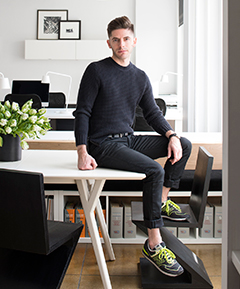Meet the Minds Behind Restaurant Design – BHDM Design
NOVEMBER 3, 2015
Founded in 2008, New York-based BHDM Design is led by partners Dan Mazzarini and Brian Humphrey, who have together worked on hotels, restaurants, and retail outlets for more than 35 years. The team’s portfolio includes an array of Manhattan eateries, including Omar’s, the Lion, and Hogshead Tavern. Here, Mazzarini talks the firm’s upcoming projects, family influence, and creating a design narrative.
Did you always know you wanted to be a designer?
Yes, as kid I used to take big sweater boxes from Kaufmann’s [department store] and make diorama houses inside. In high school, I made them offer a class on interior design, where I promptly recalled all my diorama making skills.
What are some of your first memories of design?
My grandfather was a talented artist. He used to draw black and white cartoons for us to color and was always encouraging us to be creative, whether singing, painting, drawing, or building. I think he’d be really happy to see what I’m doing now, since we definitely do all these activities in our office at BHDM.
Did where you grew up influence your career path?
Maybe not Pittsburgh itself, but my family and home were certainly inspirational. My mom was never afraid to get her hands dirty and was always getting into projects, especially when my dad was out of town. He’d leave (with his house in one piece), and when he’d come home we would have all the wallpaper pulled off the dining room walls. ‘Guess what—we’re doing a project!’ was heard a lot in our house.
Give us a bit of your background: college, first jobs, early lessons learned.
I went to school for interior design at Miami University in Oxford, Ohio. I was convinced I needed to be in New York and was gung-ho [about attending] the Pratt Institute, but my parents suggested I do at least one year at a liberal arts school. I conceded, and it ended up being the best decision I could have made. It was a great program and experience—I’ve hired half of our office from Miami University.
During the summer I did everything from work at Pier 1 Imports—where I was fired twice—to mall jobs, and even worked at a gas station. I was saving money to do a study abroad in Italy, so I worked all the time. After my sophomore year I took an internship in Chicago with the Environments Group [since merged with Perkins+Will] working in corporate interiors. They were the loveliest people to work with.
Upon graduation I set my sights on New York. I came to interview and was sold when I saw Claire Danes getting out of the subway. Though the economy was not so great in 2003, I accepted an offer from Kramer Design Group. They are still the three most formative years of my career. Robin Kramer was an insightful businesswoman and a kind, empowering boss. I learned all I know about retail design while I was there, in addition to good people management [skills].
Why and how did you start your own firm?
Our firm started pretty organically while I was still [working] full-time at Ralph Lauren. One project led to another, and before I knew it I was doing two full-time jobs. As much as I’d always imagined myself having a company, I realized there was never going to be the perfect time to start a business, so I gave a long notice and gradually started working more and more on my own.
Can you discuss some of your recent projects?
We have a number of projects coming up, such as a hotel in Greenport, New York (American Beech), which is beachy and summer-like; an Indian restaurant in New York that we are pretty jazzed about (Indian Accent at Le Parker Méridien); and a rollout of Scandinavian bakeries (BROD Kitchen). We also have a few residential projects, retail projects, and an office project in London (AXIOM London).
Is there a challenging project of which you are especially proud?
Lords Hotel in South Beach (since renamed the Stiles Hotel) was one of our first commercial projects and our first hotel. We worked super hard and fast on this one, and thought about everything from the environment, to the uniforms, bellhop cart, key card—you name it. It turned out to be a great project for us, full of witty spirit. It won the 2011 HD Award for midscale hotel, which was very gratifying.
What are you looking forward to at your office?
We have some projects coming to fruition that we’re jazzed to see. We helped define the concept of an upcoming food hall for chef Claus Meyer at Grand Central Terminal—opening in 2016. We’re also looking forward to a great summer at the American Beech Restaurant and Inn we’re developing in Greenport.
I’m personally most excited for all the growth that’s happening with our business. We’ve been around for about three years, and it seems that our work and name is catching on in the hospitality world—a very gratifying thing for me.
What do you find are the most challenging and exciting aspects of your job?
As a small business owner I wear a lot of hats, so my time seems to keep diminishing. I think the biggest challenge is to let go of the day-to-day design and focus on delegating and becoming a great editor. It’s the reality of owning a business.
What is the most important thing to remember when designing a restaurant—both in terms of branding and interiors?
Hospitality spaces are, by definition, transient. You’re there for a pit stop or escape from your everyday life. To that end, they should be transformative spaces that are theatrical, unexpected, and fun. We like to think about the experience as a narrative, and to tell the story at every turn, object, and item. How does the logo and menu design help tell the story? What’s the experience walking through the door, or looking across the room? For us, the narrative is what should drive the design and what will help inform every design decision.
Is there an architect or designer you most admire? Why?
We’ve always loved the work of David Rockwell, the master of narrative design. Yabu Pushelberg continually puts out incredibly elegant and edited projects. And Philippe Starck continues to concoct quirky, unexpected, and theatrical spaces.
What would be your dream project and why?
I think a casino project would be great. Coming up with a new concept and working at such a large scale would be a lot of fun. Casinos are all about over-the-top [design], and it would be fun to pull out all the stops.
If you could have dinner with anyone, living or dead, who would it be?
I think it would be my grandfather. I’d like him to see what I do and to ask his advice on a few things.Where would you eat and what would you be having?I don’t know where we’d eat dinner, but I know where we would have dessert. There was this ice cream place where we used to go when I was a kid, and they had the best soft-serve black raspberry ice cream. If you weren’t a designer, what would you be?I think I’d be somewhere between an English major and a theater person—maybe a screenwriter.

